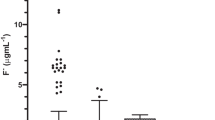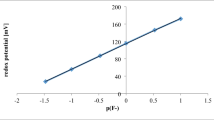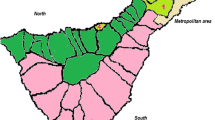Abstract
The purpose of this study was to assess the fluoride content of Ceylon Tea, which is a popular beverage throughout the world. The fluoride content of tea infusions prepared from different grades of tea leaves collected from different parts of the tea-growing regions (25 samples) of Sri Lanka was measured using a fluoride-selective electrode. Fluoride leaching was found to vary from 0.32 to 1.69 mg F/l, but there were no significant differences in terms of fluoride leaching between tea from different tea-growing regions or between tea of different grades. Dental fluorosis is widespread throughout the dry zone of Sri Lanka, and drinking water has traditionally been considered to be the main contributory factor to the development of fluorosis. However, diet, the consumption of tea in particular, may also contribute to the manifestation of dental diseases.



Similar content being viewed by others
Reference
Cao, J., Luo, S. F., Liu, J. W., & Li, Y. (2004). Safety evaluation on fluoride content in black tea. Food Chemistry, 88, 233–236.
Dissanayake, C. B. (1991). The fluoride problems in the groundwater of Sri Lanka, environment at management and health. International Journal of Environmental studies, 38, 137–156.
Dissanayake, C. B. (1996). Water quality and dental health in the dry zone of Sri Lanka, In J. D. Appleton, R. Fuge, G. J. H. McCall (Eds.), Environmental geochemistry and health (Vol.113, pp 131–141). UK: Geological Society special publications.
Dissanayake, C. B., & Chandrajith, R. (1999). Medical geochemistry of tropical environments. Earth Science Reviews, 47, 219–258.
Duckworth, C. S., & Duckworth, R. (1978). The ingestion of fluoride in tea. British Dental Journal, 145, 368–370.
Fung, K. F., Zhang, Z. Q., Wong, J. W. C., & Wong, M. H. (1999). Fluoride contents in tea and soil from tea plantations and the release of fluoride into tea liquor during infusion. Environmental Pollution, 104, 197–205.
Graham H. N. (1992). Green tea composition consumption and polyphenol chemistry. Preventive Medicine, 21(3), 334–350.
Lung, S. C., Hisao, P., & Chiang, K. M. (2003). Fluoride concentrations in three types of commercially packed tea drinks in Taiwan. Journal of Exposure Analysis and Environmental Epidemiology, 13, 66–73.
Malde, M. K., Greiner-Simonsen, R., Julshamn, K., & Bjorvatn, K. (2006). Tealeaves may release or absorb fluoride, depending on the fluoride content of water. Science of the Total Environment, 366, 915–917.
Recommended Dietary Allowances (1989). Food and Nutrition Board, Commission on Life Sciences National Research Council. (10th ed.). Washington D.C.: National Academy Press.
Shu, W. S., Zhang, Z. Q., Lan, C. Y., & Wong, M. H. (2003). Fluoride and aluminium concentrations of tea plants and tea products from Sichuan Province, PR China. Chemosphere, 52, 1475–1482.
Walters, C. B., Sherlock, J. C., Evans, W. H., & Read, I. (1983). Dietary intake of fluoride in the United Kingdom and fluoride content of some foodstuffs. Journal of the Science of Food and Agriculture, 34, 523–528.
Warnakulasuriya, K. A. A. S., Balasuriya, S., Perera, P. A. J., & Peiris, L. C. L. (1992). Determining optimal levels of fluoride in drinking water for hot, dry climates–a case study in Sri Lanka. Community Dentistry and Oral Epidemiology, 20, 364–367.
Yang, L., Peterson, P. J., Williams, W. P., Wang, W., Ribang, L., & Tan, J. (2003). Developing environmental health indicator as policy tools for endemic fluorosis management in the Peoples Republic of China. Environmental Geochemistry and Health, 25, 281–295.
Acknowledgements
RC gratefully acknowledges the award of the George Forster Research fellowship from the Alexander von Humboldt Stiftung, Germany.
Author information
Authors and Affiliations
Corresponding author
Rights and permissions
About this article
Cite this article
Chandrajith, R., Abeypala, U., Dissanayake, C.B. et al. Fluoride in Ceylon tea and its implications to dental health. Environ Geochem Health 29, 429–434 (2007). https://doi.org/10.1007/s10653-007-9087-z
Received:
Accepted:
Published:
Issue Date:
DOI: https://doi.org/10.1007/s10653-007-9087-z




